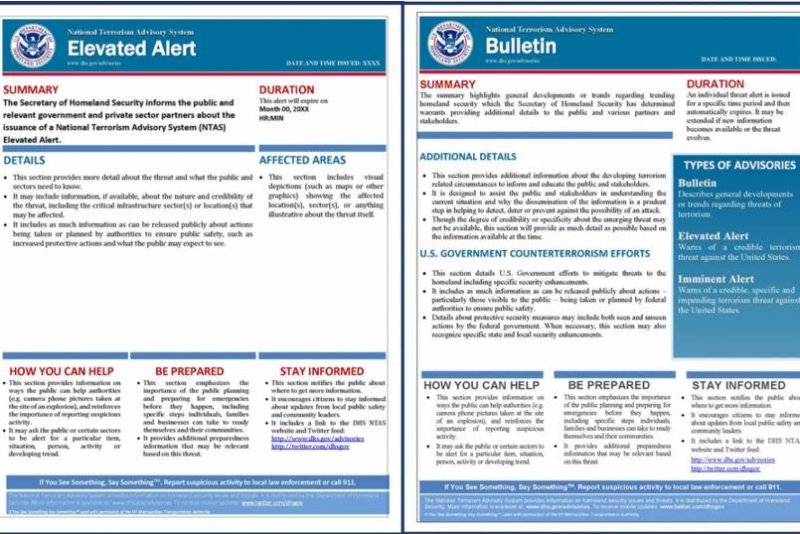The U.S. Department of Homeland Security on Wednesday announced a change to the National Terror Advisory System, which adds a "bulletin" advisory level to better address changing aspects of terrorism -- such as domestic and "lone wolf" threats. Image courtesy U.S. Department of Homeland Security
WASHINGTON, Dec. 16 (UPI) -- The U.S. Department of Homeland Security on Wednesday announced a major change to the National Terror Advisory System to help meet the evolving landscape of homegrown threats.
The NTAS, which replaced the color-coded Homeland Security Advisory System in 2011, is an alert scale that aims to inform U.S. citizens of potential terror threats by citing specific details and dates.
Specifically, Wednesday's modification adds a second advisory type to the system. Previously, "alerts" were available in two categories: "elevated" and "imminent." Now, the system will also consist of "bulletins," which DHS officials say will "provide information describing broader or more general trends and current developments regarding threats of terrorism."
The change is intended to better address terrorism with domestic and "lone wolf" dimensions -- similar to the recent attacks in San Bernardino, Calif., and Paris.
"Particularly with the rise in use by terrorist groups of the Internet to inspire and recruit, we are concerned about the 'self-radicalized' actor(s) who could strike with little or no notice," the department states in the first bulletin, issued Wednesday. "DHS is especially concerned that terrorist-inspired individuals and homegrown violent extremists may be encouraged or inspired to target public events or places. As we saw in the recent attacks in San Bernardino and Paris, terrorists will consider a diverse and wide selection of targets for attacks."
Wednesday's bulletin covers the next six months, officials said, and will be amended to reflect new or changing threats.
"People are anxious now. They should know, they need to know what their government is doing to protect our homeland," DHS chief Jeh Johnson said at a news conference Wednesday.
Last week, Johnson said the department was working on an alert system upgrade and promised it would be introduced in the coming days.
"In 2002, we went to the color bars," he added, referring to the system implemented under President George W. Bush six months after the Sept. 11, 2001, terror attacks. "One of the issues with the color bars was that there was very little public commentary to go with them."
During his announcement, Johnson outlined 10 points detailing the department's strategy to fight terrorism -- including bombing campaigns in Iraq and Syria, increased aviation security, increased inter-agency communication and heightened public awareness.
"[The single advisory system] in my judgment does not work in the current threat environment because it depends upon a specific, credible, terrorist threat to something in the homeland," Johnson said. "We are creating an intermediate level to the NTAS system that includes an NTAS bulletin that describes general developments or trends regarding threats."
Johnson encouraged Americans to familiarize themselves with the new system and visit the DHS website.
"The update to the NTAS announced today will allow us to better achieve the goal of making sure Americans across the country have the information they need to keep themselves and their communities safer,' the DHS said.
Though the NTAS has been in place for four years, to date it has not yet been utilized.















